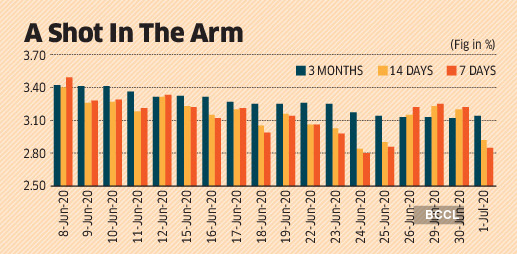Mumbai: Concerns about government finances are easing with the short-term treasury-bill yields declining to levels below the reverse repo, yielding negative real rates for the first time since the global financial crisis a decade ago.
Treasury bills are sovereign papers with up to one-year maturities.
“Investors are now looking to invest in shorter-term papers as they would not want to lock in long duration in lower rates,” said Ritesh Bhusari, deputy general manager at South Indian Bank. “This, coupled with surplus liquidity in the system, is dragging T-bill rates down.”
That has made it cheaper for the government to borrow short-term money. To be sure, the banking system has a surplus of Rs 4.36 lakh crore. Since the past four weeks, yields have started dropping due to increased demand for T-bills, surplus liquidity and no new sale of cash-management bills.

The seven-day T-bill yields plunged 64 basis points since June 8 to 2.85 per cent, data gathered by Financial Benchmarks India showed. The 14-day series tanked 48 basis points. A basis point is 0.01 percentage point.
Yields on the three-month paper, billed as the most liquid of securities, dropped 28 basis points.With some cash management bills maturing and net treasury bill supply lower in the quarter ahead when compared with the previous quarter, the supply of paper has also reduced,” said Suyash Choudhary, head-fixed income at IDFC Asset Management. “This may be putting further downward pressure on yields at the very short end.”
On July 1, the Reserve Bank of India (RBI) auctioned Rs 35,000 crore worth of treasury bills. Yields on treasury bills had climbed up to 56 basis points since May 22, when the RBI cut the benchmark rate to a record low, with the government raising Rs 80,000 crore via cash management bills outside the borrowing calendar, ET reported on June 8.
Also Read: How Sensex, gold, 10-year G-sec performed during week ending July 2, 2020
The real rate, or the differential between one-year treasury bills and projection of consumer price rises, is also turning negative.
While the one-year sovereign papers are yielding around 3.45 per cent, the RBI projected inflation is in the range of 3.6-3.8 per cent up to 2022.
The central bank has conducted a switch auction Thursday, buying Rs 10,000 crore of long-dated papers while selling treasury bills of a similar quantum.


